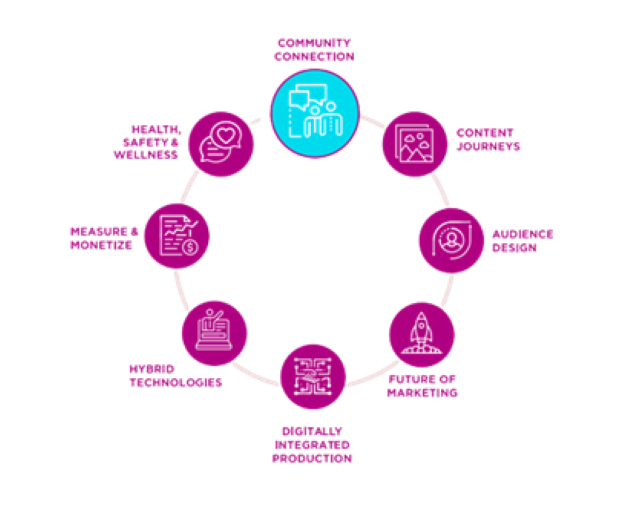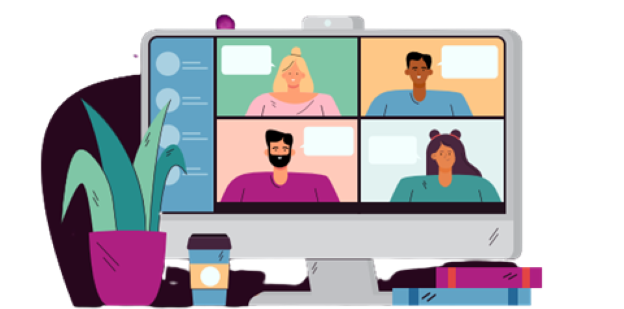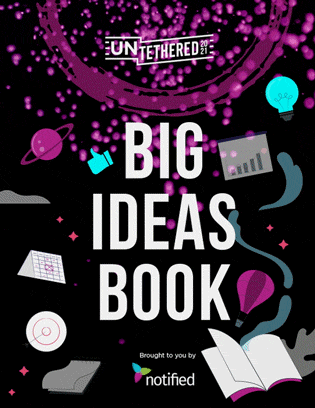It’s time to find new ways to think about old problems, and old tricks to use on new problems.
With the always changing digital events landscape comes new goals and challenges. Whether it’s virtual, in person, or hybrid, your event strategy needs to be unique to your business needs and those of your audience.
Our Big Ideas Book is full of mind-blowing moments and practical tips from industry experts such as Intel, Microsoft, NASA, and the Virtual Event Institute that anyone can incorporate into their next event.
Broken into 8 chapters, this book covers the most important concepts to think about when building an event strategy. Here are some of our favorite tips from each chapter!
1. Design an Event That’s Tailored for Your Audience
Understanding Your Event Audience
The topic of this chapter is fundamental to good event planning. All the keynotes, breakouts, and activities in the world won’t matter much unless we first understand our audiences.
When you take the time to get to know their attendees on a deeper level, it allows them to develop a creative theme, visual identity, and customer journey for their events that makes the user feel more connected to the brand, the message, and other attendees.
Find out what motivates your attendees, what are their likes and dislikes, or how they prefer to engage in online environments.
Try some of these tactics to get to know your audience a little better.
- Focus groups
- Surveys
- Analyze past attendee data
- Analyze social media for attendee feedback
2. The Event Content Journey
Creating Meaningful Engagement in Your Hybrid Environment
The content journey focuses on how to create an end-to-end content strategy across all touchpoints. It’s not just about education or knowledge transfer. It’s also about relationships: meeting other people, collaborating, and growing together.
Think of a content journey as a progression from beginning to end. What are attendees thinking, seeing, feeling, and doing over the course of the event? Your events content journey needs to be unique to fit your audiences’ specific needs by providing engaging, accessible, and inclusive content geared to different learning styles.
Here are some ways to engage your virtual audience:
- Keep the viewers engaged in the chat section
- Use built in polling and Q&A features
- Sprinkle in some micro-keynote sessions
- Provide engaging problem-solving activities for your audience to participate in
3. Increase Event Engagement Through Community Connection

Creating an Inclusive Environment
The overall goal of events is to build a community. The event goes beyond just the live program; there are multiple touch points and actions to take before, during and after your event that can help create an inclusive experience that keeps people engaged and relationships going long after the final session.
Your event is more than just a moment in time – it’s part of a process of building community for years to come. And believe it or not, people feel more comfortable making connections in a digital environment rather than in person.
4. The Future of Event Marketing
Measuring Your Event’s Success
It’s a brave new world of event marketing. Events are closer to the marketing mix than ever before. We have more data, more apps, and more tools at our disposal than ever before. We also have access to much more content thanks to the rise of in-person, virtual, and hybrid events.
The event marketing space is continuing to grow and won’t be slowing down anytime soon. So, how can you take advantage of all the resources without getting overwhelmed?
Here are a few tips to deliver more value to sponsors, partners, and attendees:
- Keep virtual and in-person events separate in your KPIs
- Create and track attendee touchpoints throughout the event
- Create incentives people don’t want to miss
- Breakdown your attendees into smaller subgroups
- Showcase your exhibit booth
5. Digitally Integrated Production
Connecting Your Digital Audience
We often hear that when we are planning for hybrid events, we need to be planning two separate events. While there is some truth behind this statement, that doesn’t mean they have to be two separate experiences.
It shouldn’t be one or the other – in person and virtual should complement each other and make the overall experience for the audience members more memorable.
With all these moving parts, hybrid events can seem complicated, use these tips to ensure smooth sailing for your next event:
- Pre-record certain event sessions
- Ensure your minimum internet upload speed is 30-50 mbps
- Provide audio only sessions
6. Hybrid Event Technologies

Connecting Remote and In-Person Audiences
As previously mentioned, the events space has gone through drastic changes in the last few years and moving forward, it appears most events will feature both in-person and virtual components. Some people might see this as a setback, but the hybrid landscape has the potential to reach more people than ever before.
Remember, the power of events is in connecting people.
While your two audiences will not be sharing the same experience, there are endless ways to create content that is authentic and meaningful that will help combat digital fatigue.
Here are some tips to create high-value event engagement:
- Create breakout sessions that encourage collaboration across the digital divide
- Create a hybrid wellness session
- Keep groups small
- Create content that’s meaningful to your audience
7. Measure and Monetize Your Event Success
Now that we’re in a digital and hybrid event world, we’ve got a host of tools that allow us to sift for gold in all that data gravel. Plus, there’s an endless number of opportunities to monetize the digital experience.
People have become more open to connecting digitally and data is showing that audience members are more comfortable interacting in a digital environment than at an in-person event. We’ve also found that there’s less small talk. People dive right into the heart of the matter.
Remember, always start with your “why?” to determine how you want to measure your event’s success.
8. Prioritizing Your Event Health, Safety, and Wellness Goals
Creating a Safe Event Environment
And last, everyone’s favorite topic: health and safety. It seems that nobody likes talking about safety —until we start talking about safety. Safety should always be the number-one priority and the best way to do it is to create a safety culture.
As people begin to come together indoors again, they may be skeptical, tentative, and even a touch fearful. Your job is to ease their worried minds by taking steps to make their safety paramount.
Here are some easy ways anyone can make safety a priority:
- Communicate your expectations
- Stand firm on your boundaries
- Educate your attendees
- Create safety videos or info graphs
Your Event, Your Way
Put Your Audience First and Design Event Experiences Catered to Their Needs
As you plan for your next event, Notified is here to help bring your vision to life.
If you enjoyed these tips, download our full Big Ideas Book to read even more mind-blowing moments and practical tactics from industry experts to help you plan for your next event.
Enjoy!

